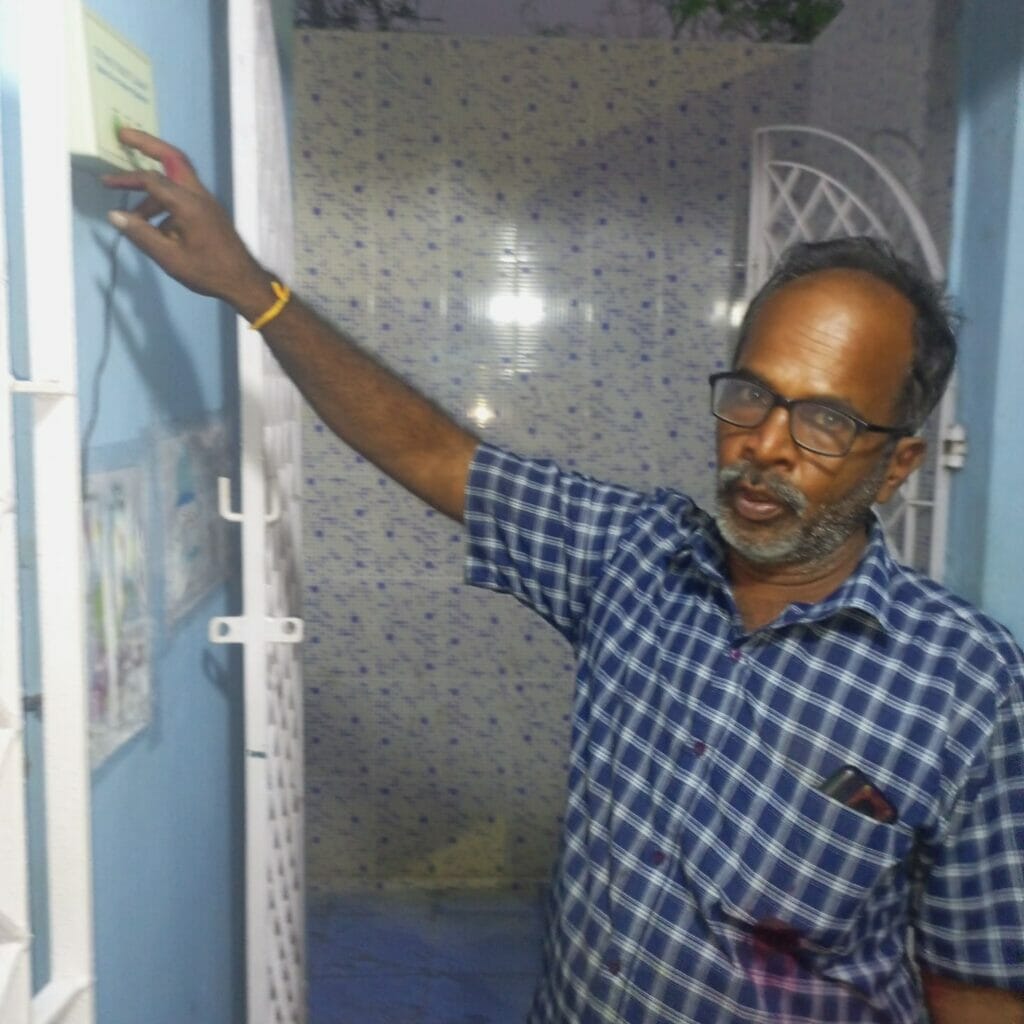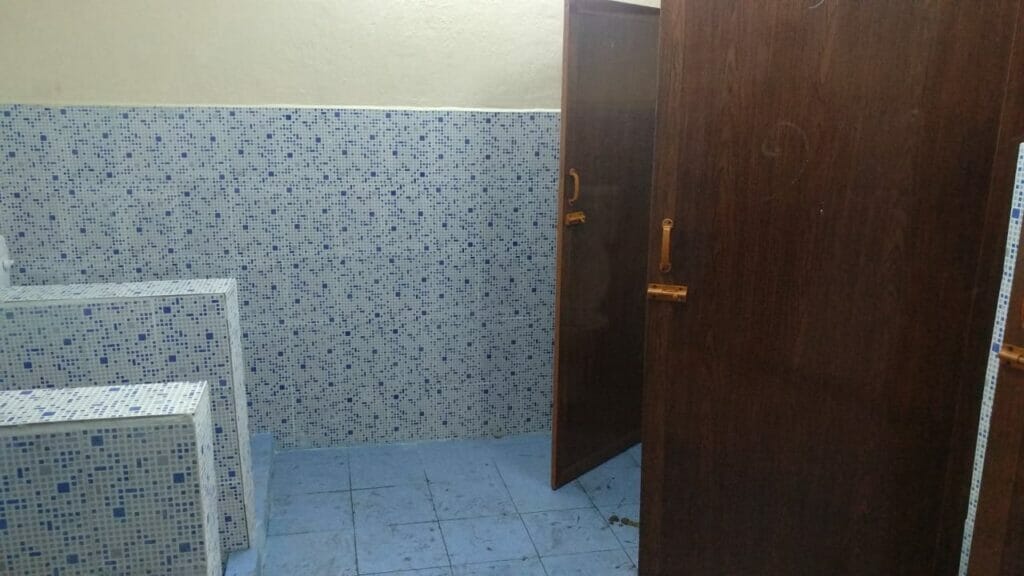Access to sanitation is a human right, according to the United Nations. But when we conducted a spot-check of some public toilets in Chennai, not all of them were accessible, safe and usable.
While the Greater Chennai Corporation (GCC) has made sure that the public toilets are free to use, many people do not yet have complete physical access to toilets or a safe and clean set-up to use with dignity.
For instance, 128 families of around 400 people in Kannappar Thidal use the community toilet with four usable cubicles for women and six for men.
Read more: Kannappar Thidal: Where residents continue their 20-year wait for a proper home
Currently, there are 812 toilets across the city, all under GCC. Some toilets with high footfall like the ones near beaches and transit stops are open round the clock, while some of them have timings. Zonal officials decide the timings of the toilets in their respective zones.
But GCC says it has a plan to revamp Chennai’s many public toilets that are in dire need of attention.
Public toilets and open defecation in Chennai
Even as the Greater Chennai Corporation claims Chennai to be open defecation-free and has applied for a three-star rating in Swachh Bharat Mission 2.0, the reality seems otherwise. Many areas across Chennai have seen open defecation in recent times.
“Construction labourers among other workers treat Korattur lake as a large open toilet,” says S. Sekaran, the secretary of Korattur Aeri Padukappu Makkal Iyakkam (KAPMI).
“There are no public toilets in our area. I have heard that workers do their business behind garbage bins,” says DK Sivakumar, the vice president of the AGS Colony RWA in Velachery.
Manali also has a stretch where one can see defecation near the road.
“The main problem to combat open defecation is the numbers. There are not enough toilets for a large number of people in some communities,” says Ganga Dileep C, Founder-CEO and Principal Architect and Urban Designer at Recycle Bin, an NGO and consulting firm that has also been working on public toilets in Chennai.
“For bathing and washing, people living in slums prefer to do it near their houses. For urinating also, people use their houses- they dig a hole in their house that connects to the sewer or stormwater drain,” says Ganga. “Better operation and maintenance of the limited number of public toilets can also increase patronage, reducing open defecation instances.”
In a survey conducted by Recycle Bin, they observed that open defecation was very prevalent among the babies of the slum on Pumping Station Road. “Even one-year and two-year-old babies are kept outside their houses. Moreover, toilet training is missed out. If we look at younger school-going kids, diarrhoea is very common and open defecation is a cause. So, Recycle Bin renovated the community children’s toilet with open and closed cubicles,” describes Ganga. “So, this initiative is to bring toddlers who are defecating in the open to the toilets.”
“When refurbishment works are done on the toilets, we keep at least one toilet open for people to use, to prevent open defecation,” says Donata Mary Rodrigues, Senior Consultant at Tamil Nadu Urban Sanitation Support Programme (TNUSSP). TNUSSP has piloted operations and maintenance models for 11 toilets in zones 13 and 14.
Challenges in running public toilets in Chennai
Maintenance of public toilets comes with myriad issues across Chennai, leading to open defecation as the toilets are not fit for use.
Locked toilets: Experts say that sometimes those toilets could be maintained by solid waste management workers. When they are not around, they might close the toilets, making the inaccessible to the general public.
Water availability not guaranteed: “Sometimes the bore gives up, and we have to make alternate arrangements for water. One of our toilets is facing that challenge. Also, we have water metres in our toilets to understand the trends in water usage,” says Donata.
Sewage blockage: “In Chennai, Metro Water maintains the sewerage while GCC maintains the toilets. Converging with both departments is a bit hard,” says Donata.
Read more: Living with sewage: Fishing hamlets in Chennai’s Kottivakkam see no end to drainage woes
User behaviour: “People do not always use the toilets responsibly. There are some cases of vandalism too. Sometimes they press the flushes hard and tend to break them. However, vandalism has reduced greatly in our toilets. So, we are also working to change the user behaviour of the people,” says Donata.
Experts also point out other hindrances that users cause, especially vandalism acts are some of the key reasons for the poor state of public toilets. “Sometimes people consume alcohol and throw the bottles inside the flush. Sometimes toilet cubicle doors and fixtures are broken, especially in community toilets,” says Ganga.
“To prevent vandalism, it is good to have CCTV cameras outside the toilets,” notes Donata.
Public toilet maintenance models piloted in Chennai
In January 2022, the TNUSSP, the technical support unit of the State Municipal Administration and Water Supply department assessed the status of the then-situation of 62 toilets in zones 5, 6, 9, 10, 13 and 14.
TNUSSP is part of the committee that gave inputs for the request for proposal in Phase 1 of the PPP project stated above.
Public toilets in Chennai sometimes suffer from a lack of maintenance personnel in the toilets, no proper lighting and unavailability of water. Other times, they are even locked, as we saw in the photo story. Another issue was that the maintenance personnel of some toilets were unofficially collecting money, as stated in a press release by GCC.
After the assessment, the operations and maintenance models for 11 toilets were evolved.
“Zone 13 toilets had sewerage, while zone 14 did not,” says Donata. “The reason for taking non-sewered toilets is to try improved on-site sanitation.”
Indian Institute for Human Settlements (IIHS) funds the operation and maintenance of these 11 toilets at the moment.
TNUSSP rolled out these models in the toilets managed by them:
- Private facility management company: “We gave the company five toilets [to manage],” says Donata.
- Women SHGs operating and maintaining toilets: “We onboarded two area-level federations in zones 13 and 14. Also, a group like area-level federation came forward,” she says. Another toilet under construction will be handed over to an SHG.
- Individual entrepreneurs getting involved: “From January 2023, an individual entrepreneur is managing a toilet.” Another toilet is under construction, which will be handed over to an entrepreneur.
“In the toilets that TNUSSP has taken over, the usage of the toilets has increased three to six times. Most of our toilets are open 24 hours and are kept clean,” notes Donata.
The maintenance personnel also keep a record of the number of people using the toilets and the consumables being used every day.

At Kottivakkam beach (non-sewered toilet in Zone 14), TNUSSP has brought about multi-user reinvented technology {MURT), which is like a mini sewage treatment plant. “It can treat 5000 litres of sewage water every day. This water can be recycled to be used for flushing, cleaning toilets and gardening. The test run is going on in that toilet,” Donata describes. TNUSSP will try variations of MURT in two other toilets.

Behavioural change of users is important to sustain public toilets
Behavioural change cannot be achieved overnight, says Donata. “We are coming up with community engagement initiatives. In every toilet maintained by TNUSSP, we have put up a board about using the toilets regarding hygiene and toilet etiquette. Other activities and campaigns are also lined up. For instance, on World Toilet Day, we took a pledge with people. Also, there are ideas for community monitoring groups and RWAs and shopkeepers to help with toilet monitoring.”
Among the three models that TNUSSP is piloting, the toilets maintained by women SHGs fare better in community engagement. “We gave additional training to the private enterprise-run toilets on community engagement. Community engagement involves instructing the public about how to use the toilets [responsibly]; and organising meetings and rallies with the local communities to find their needs for toilets,” says Donata.
“A toilet will need one person 24/7 to monitor,” says Ganga. Users will not take the toilets for granted and this will also streamline responsible usage.
Recycle Bin has been renovating community toilets, apart from bringing about behavioural change campaigns in slums, including livelihood activities.
“We have made a toolkit for making toilets accessible from a physical access and gender point of view. Then, we constructed 50 toilets in the city to understand the physical infrastructure part of the toilet. We made a design toolkit for non-binary and trans people apart from disabled people,” explains Ganga
Recycle Bin is planning to implement the toolkit in 15 toilets in zones 5 and 9.
Public-Private Partnership (PPP) on the cards for public toilets in Chennai
A roadmap for public toilets in Chennai involves the civic body partnering with private entities.
“Private parties will construct or renovate the toilets apart from operating, monitoring and maintaining them, and it is going to be a nine-year contract. This project will be undertaken in phases,” says a GCC official.
“Although the maintenance of some of the public toilets is privatised currently, they have not been outsourced to private contractors fully. The PPP involves complete outsourcing,” says T. Saravanabavanantham, Superintendent Engineer (SE) of Buildings in GCC.
The civic body will contribute 40% of the amount for the construction or refurbishment of toilets, and the private player will contribute 60%. After the toilets are built or renovated, GCC will reimburse the amount spent by the private entity.
“Technical consultants have surveyed the existing conditions and there has been a proposal for the construction of new toilets based on demand and location,” says the official, answering on what basis will the toilets be built.
Phase 1 of the project includes the toilets in zones 5 and 6 and one portion of zone 9. In these zones, 372 locations with 3270 toilet seats have been identified for the PPP project. “We are yet to award the tenders to the private contractors who will take over the toilets,” says the official. “By next year, we hope the toilets from Phase 1 will open for the public.”
Then, Phase 2 will include 7, 8, rest of 9 and 10 zones. “The surveys are going on for the toilets in these zones,” says the official.
Phase 3 will involve the zones from 11 to 15 and Phase 4 will include zones 1 to 4. The last two phases are yet to be chalked out.
The private contractors can put up advertisements for revenue, and for the public, it will be still free to use. “The new toilets will have top-notch design and it will be made very user-friendly, like the ones you see in airports,” says Saravanabavanantham.
While the toilets are getting built or renovated, alternative toilets may be available at a distance of 200 to 500 metres for the public to use, says the SE.
While ambitious efforts are underway to remake the public toilet infrastructure, joint efforts of the public and the civic body are necessary for its continued maintenance and for Chennai to attain legitimate open defecation-free status.